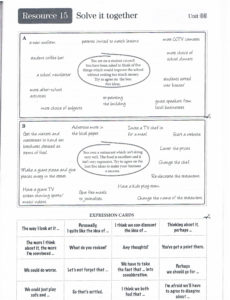Problem Solving lesson
ESL Whole lesson activity – Solve it together!
ESL whole lesson activity
Background
Back again with another lesson idea for ya peeps. Unlike all the previous ones posted, this one is straight out of a teacher’s book activities section and I’m not going to pretend otherwise. You can find the scan of the doc at the bottom of this post. It’s been an activity I have used time and time again for students ranging from 15 years old to adults. It’s meant to be for Advanced students but upper-intermediate students can handle it as well. I’ve used it because it offers great practice using language for problem solving/ working together/ discussion. You can supplement this language with another original lesson idea I’ve created on Tackling issues as well as the debate lesson. Both are perfect for the language introduced here.
The language headings are:
Expressing your point of view, Asking for opinions, Agreeing, Proposing an alternative and Summarizing.
Activity setup
Here is the language for these headings:
The way I look at it…., Personally, I quite like the idea of…., I think we can discount the idea of…., Thinking about it, perhaps…., The more I think about it, the more I’m convinced…
What do you reckon? Any thoughts?
You’ve got a point there. We could do worse.
Let’s not forget that…, We have to take the fact that…into consideration. Perhaps we should go for…., We could just play it safe and….
So that’s settled. I think we both feel that…, I’m afraid we’ll have to agree to disagree about…
Instructions and rationale
These categories of language are beneficial for everyone and can be used in countless situations. From a practicality standpoint it’s gold! Students have to first sort out the language into the categories they go into.
You can give them the categories or for an extra challenge ask them in pairs or threes to group the language into five categories they think they correspond to. Once students have done this you have to go through the language with them and on the board classify all the language in the appropriate heading. While doing this you will probably have to give examples and explain some of the less known language (there is some). Accept valid arguments from students if they argue that some language could potentially go under more than one heading.
From here you move to the practice stage.
Activity practice
Students are given two separate scenarios with multiple options to choose from. As you’ll see from the scan of the worksheet I’ve included below the scenarios are quite different but offer plenty of room for discussion and opportunities to use the language covered. The beauty of it is that in each scenario students can use the language cards in two different game-like ways. In the first scenario ask them to place the cards in front of them and then each time they use some language from a specific card to flip it over to show that it has been used. If they can manage to use all the language all the cards will be face down, success! In the second scenario students split the pile of cards evenly and then each time they use a language card they have they pass it on to their partner. If one person is using their language cards more than the others then they will have less cards then the rest. boom! So there is a bit of competition here as well. Nevertheless, emphasize that students should discuss every option for each scenario and give justifications and reasons for why they like/dislike the proposed ideas for each problem.
Feedback
For each scenario get feedback from the groups on what five options they chose as the best solutions to the problem and make sure you get reasons for their decisions. This can create a great feedback session because groups will inevitably have different solutions to the problems.
Cut up this handout for each pair/group so you’ll need some scissors and paperclips for this and have at least 5 sets ready but remember you can keep that for alter and use them again for another class 🙂 You are rocking! This is beneficial, requires little preparation, gets students working in the class for the whole 90 minutes (you’ll need 90 for this lesson) and allows you the teacher to monitor, correct and facilitate answers and feedback throughout the lesson. I’ve used this lesson in a teacher observation and my observer was extremely pleased with the class. Students are engaged the whole time so you really are covering all the bases here! I know it’s not something built from scratch but you need some of these types of activities/lessons for the weeks or days where you didn’t have as much time to prepare, it happens, who are we kidding! Please feel free to comment on this and remember to follow the twitter and facebook pages for additional resources or simply if you have questions on any of the lessons, otherwise email me. Best of luck, enjoy the teaching cause students will enjoy your lesson more….
Enjoyed this lesson idea? Want more? You can click on the subheading or footer link titled lesson ideas for more or check out my YouTube channel with videos on language, teaching and more ESL ideas. Happy hunting!


